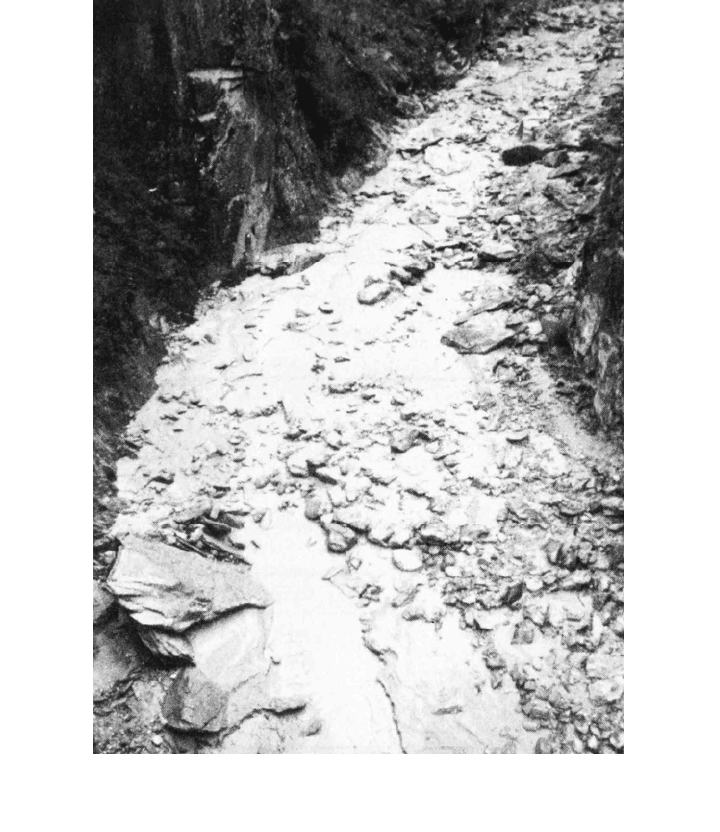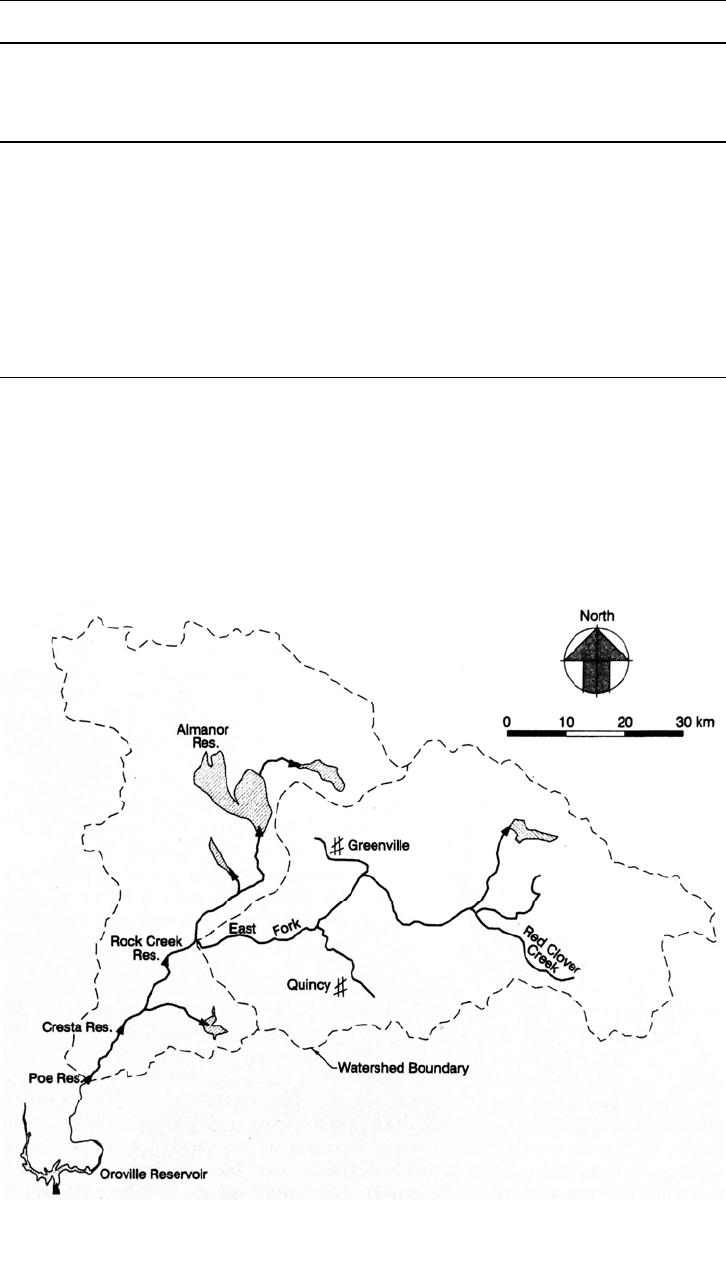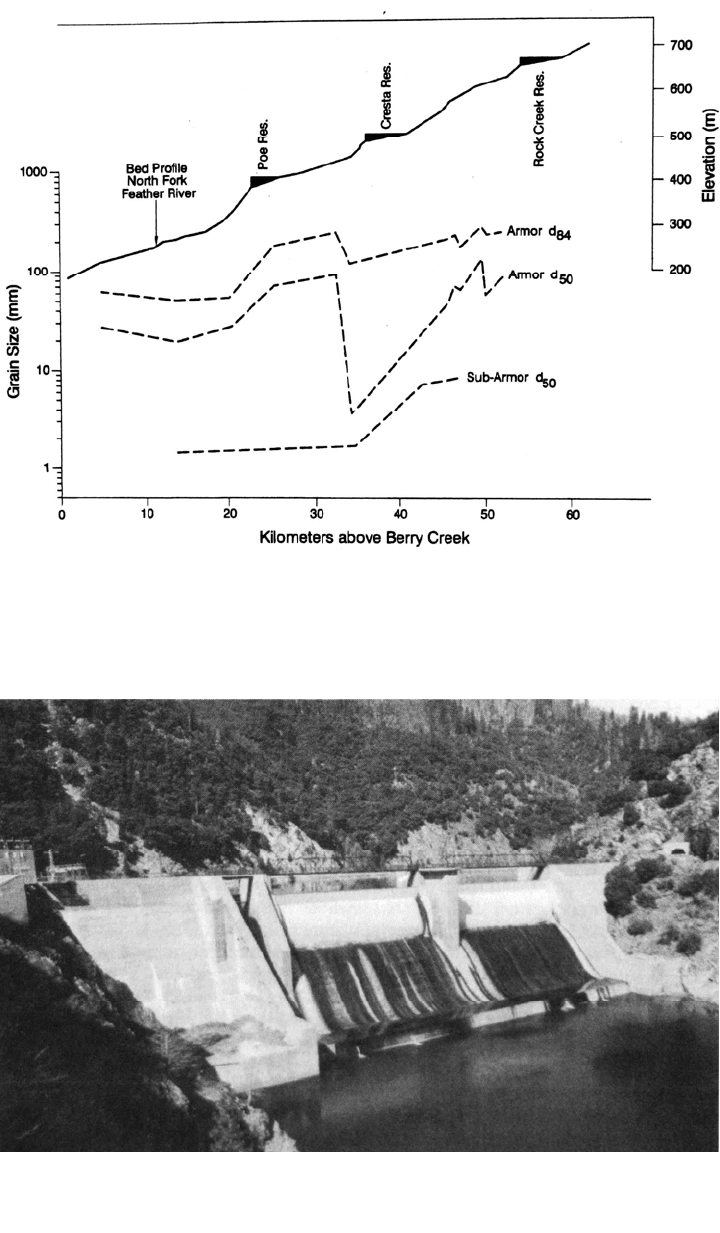Morris & Fan. Reservoir Sedimentation Handbook
Подождите немного. Документ загружается.


GEBIDEM DAM AND RESERVOIR 21.10
amount of water required for flushing is not determined by sediment removal from the
reservoir, but by the transport-limited conveyance channel downstream of the dam.
FIGURE 21.10 Photo of sediment in the gorge 200 m downstream of darn showing a
layer of fine sand deposited over cobbles and boulders (G. Morris).
The Rhone is a fast-flowing gravel-bed river which has been severely altered by
channelization along virtually its entire reach above Lake Geneva. It has also suffered
from a long history of extensive aggregate extraction. The release of flushing sediments
into the Rhone appears to have no significant long-term adverse impact on current river
morphology. On the contrary, it helps maintain sediment contributions to the river.
However, the temporary high suspended-sediment loads and deposition of fine sediment
on the bed has caused some temporary inconveniences at downstream water supply
intakes, and fish kills in the Rhone River have also been associated with flushing.

CHAPTER 22
NORTH FORK FEATHER RIVER,
CALIFORNIA, U.S.A.
22.1 INTRODUCTION
Along the steep canyon reach of the North Fork Feather River draining the Sierra Nevada
mountains above Lake Oroville, California, the Pacific Gas and Electric Company
(PG&E) operates a chain of three small hydropower dams; moving downstream along the river
they are Rock Creek, Cresta, and Poe. About 40 percent of the 4587-km
2
watershed area
tributary to Rock. Creek dam is regulated; most sediment is delivered from the unregulated 2657
km
2
East Branch tributary which enters a short distance above Rock Creek Reservoir (Fig.
22.1).
FIGURE 22.1 Location map of watershed boundaries and reservoirs, North Fork Feathe
r
River.

NORTH FORK FEATHER RIVER, CALIFORNIA, USA 22.2
After 30 years of operation, the accumulation of coarse sediment and the environmental
issues related to sediment management began to interfere with the operation of these
power stations. Sediment management at Rock Creek and Cresta Dams was not
contemplated when they were constructed, and the original gate design is not well-suited
to the passage of coarse sediment. Sediment-related problems at all three dams has led to
a number of studies and remedial actions both in the watershed and at the dams.
This case study provides an example in which the owner, PG&E, has employed a two-
pronged approach to address sedimentation problems, working to reduce sediment yield
from upstream by supporting a watershed management program while simultaneously
working to develop remedial measures at the dams. Demonstration erosion control
projects initiated in the watershed in 1986 have catalyzed watershed restoration
activities across the entire East Branch and Middle Fork watersheds, an area of 8345 km
2
.
This case study focuses on the watershed management activities, which parallel many
other similar activities nationwide. At the dams a sediment routing strategy has been
developed which can produce a sediment equilibrium along the chain of reservoirs, but at
this writing the sediment routing system at Rock Creek and Cresta Dams has not yet been
initiated. Data from this case study have been drawn from site visits, interviews,
published documents, and other material kindly provided by numerous contributors.
22.2 GENERAL DESCRIPTION
22.2.1 Site Description
The North Fork Feather River upstream of Lake Oroville is a steep channel incised in a
granitic gorge with an average slope of 0.009. The river has a riffle and pool sequence
and generally contains cobble and boulder size material. Gravels occur locally,
primarily in sheltered areas or eddies. Some reaches contain large boulders (several
meters in diameter) delivered to the channel as debris flows or dropped from the steep
canyon walls. Once highly regarded as a trout stream, a combination of watershed
degradation, road and railroad construction, and hydropower development have greatly
impacted the fishery.
The river profile showing the location of Rock Creek, Cresta, and Poe Dams is
presented in Fig. 22.2. The three dams serve as forebays to power tunnels and have very
little flow regulation function; they are used to produce peaking power except during
periods of high discharge when they run continuously. All three dams are low structures
with crest gates. The smallest and most downstream dam, Poe, has underflow radial
gates which are well-suited to the passage of sediment. The dams at both Cresta and
Rock Creek are almost identical, and both are fitted with overspill drum gates which are
unsuited for sediment passage (Fig. 22.3). Characteristics of the dams are summarized
in Table 22.1.
The Feather River drains the Sierra Nevada Mountains, and elevations in the study
watershed vary from 424 m at Poe dam to 667 m at Rock Creek to 3182 m on Lassen Peak,
the highest point in the watershed. Much of the East Branch watershed is at elevations
above 1200 m, and contains numerous valleys with deep sedimentary deposits. Parent
material consists primarily of volcanics, and the overlying soils on slopes tend to be
coarse, well-drained, and relatively shallow. The vegetation consists primarily of mixed
conifer forests including yellow pine, Jeffrey pine, ponderosa pine, sugar pine, white fir,
and Douglas fir. Species composition varies with elevation and precipitation. Meadows
contain mixed grasses and wetland species, but in degraded valley bottoms where channels
have eroded and lowered water tables, the meadows have dried out and have been invaded
by drought-resistant species with little forage value, such as sagebrush.

NORTH FORK FEATHER RIVER, CALIFORNIA, USA 22.3
FIGURE 22.2 Profile along North Fork Feather River showing reservoirs and grain size o
f
material on river bars (modified from Resource Consultants and Engineers, 1992).
FIGURE 22.3 Photograph of Rock Creek Dam (G. Morris).

NORTH FORK FEATHER RIVER, CALIFORNIA, USA 22.4
TABLE 22.1 Characteristics of PG&E Hydro Dams on North Fork Feather River
Parameter Rock Creek Crests Poe
Year completed 1950 1949 1958
Original volume. 10
6
m
3
5.4 5.1 1.42
Most recent bathymetry 1994 1994 1993
Sediment accumulation. 10
6
m
3
3.1 2.45 .338
Pool length, km 4.5
Max. turbine discharge, m
3
/s 94 110
Generating capacity, MW 112 70 120
Over 50 percent of the annual precipitation of 1100 mm falls in December, January,
and February, primarily as snow above an elevation of 1800 m and a mixture of rain
and snow at lower elevations. However, warm winter storms can produce rain at
elevations as high as 3000 m. Summer months account for less than 3 percent of the
annual precipitation. Runoff and sediment transport is associated primarily with
snowmelt, which normally extends into early summer, or winter storms.
Maintenance of summer base flows in the unregulated East Fork streams depends
heavily on the drainage of shallow groundwater, including the annual cycle of
water storage and release from wet meadows along valley floors. Flow along the
impounded North Fork reach is regulated by releases from Lake Alomar.
22.2.2 Geomorphology
A geomorphic evaluation of the North Fork Feather River and the three reservoirs was
conducted to better characterize the behavior of the system and its sediment transport
characteristics (Resource Consultants and Engineers, 1992).
Within the area of the three dams, the North Fork passes along a channel incised in
granodiorite, and exhibits a step-pool geomorphic configuration characteristic of steep
channels with bedrock control. Sediment transport along the stream is limited by the
rate of sediment supply from the tributaries, and the stream profile is determined by
bedrock lithology. This pattern is in sharp contrast to lowland streams which
typically exhibit a smooth, concave, longitudinal profile that flattens in the
downstream direction, indicating that the channel is in equilibrium with sediment
supplied from the bed. Also unlike lowland or alluvial streams in which the size of
the material transported decreases regularly moving downstream, a pattern of regular
changes in grain diameter is not readily apparent along the North Fork. Instead, the
grain size in any given section of the channel reflects primarily the grain size
delivered from tributaries plus local hydraulic controls within the step-pool system.
Wide variations in grain size can occur over short distances, with finer material,
including limited amounts of gravels suitable for spawning, accumulating only
behind flow obstructions. Grain size analysis using Wolman counts for surface
material and bulk sampling for subpavement below the armor layer showed that the
channel bars were heavily armored, as evidenced by the large difference in grain
size in the armor layer and the subpavement (Fig. 22.2). A minimum of 50 percent
of the subpavement samples consists of fine gravel to very coarse sand, but this size
material is essentially absent on the surface of the bars. Comparison with historical
air photos showed that the location of boulder/cobble bars in the system has
NORTH FORK FEATHER RIVER, CALIFORNIA, USA 22.5
remained relatively constant. The core materials in these bars are remnants of
deposition from previous high-energy hydrologic regimes or catastrophic events.
22.2.3 Sediment Management History
In the early 1980s it was already apparent to PG&E that sedimentation would affect the
North Fork Feather River system. Sedimentation issues include both the operational
problems caused by sediment accumulation as well as the environmental issues
associated with sediment management techniques that would further impact the stream and
its fishery. One of the major issues was the historical degradation of spawning habitat
because of loss of gravel beds (most of the river bed is today too coarse for spawning),
combined with the smothering impact that would be caused by releasing significant
quantities of material smaller than 0.84 mm in diameter. Most of the sediment trapped in
the reservoirs fell into this undesirable size range.
Initial sediment management efforts focused on erosion control in the degraded East
Branch watershed. The Plumas National Forest manages 84 percent of the East Branch
watershed, private timber holdings constitute an additional 11 percent, private
agricultural holdings are 4 percent, and the, remaining 1 percent comprises all remaining
private and public ownership including all urban areas. More than a century of activities
such as mining, logging, and overgrazing had degraded 60 percent of the watershed.
Most sediment was derived from erosion and gullying within destabilized stream
channels, plus logging roads, and 80 percent of the sediment yield was estimated to be
the product of accelerated erosion (Clifton, 1994).
In 1984 PG&E began an effort to develop a long-term plan to manage sediment at its
reservoirs, surveying the watershed to diagnose erosion problems and initiating a series
of meetings with government agencies responsible for controlling erosion upstream of
the dams. It was apparent that watershed management could be achieved only in a
coordinated and cooperative manner, and in 1985 PG&E and 12 other agencies and
institutions joined to create a Coordinated Resource Management (CRM) group
organized under the terms of a formal memorandum of understanding. Five more institutions
have subsequently joined. The CRM goals set forth in the memorandum are to: identify
erosion sources, coordinate between public and private landowners, implement erosion
control projects where practical, ensure project cost-effectiveness for contributors, and
develop a cooperative regional erosion control plan (Plumas Corp., 1996).
A rain-on-snow event in February 1986 produced a peak discharge of 2265 m
3
/s at
Rock Creek Dam, about an 80-year return interval flood, which buried the low-level
outlets at Rock Creek dam beneath sediment and dramatically underscored the system's
vulnerability to continued sedimentation. Deposits in both Rock Creek and Cresta
Reservoirs had been surveyed in 1984, and by resurveying in 1986 the effect of this
large event on sediment accumulation was documented. The flood caused the net erosion
of 417,000 m
3
of sediment from Rock Creek Reservoir and a net accumulation of 230,000
m
3
of sediment in Cresta Reservoir. However, at Cresta the flood also caused a significant
redistribution of deposits as sediments were scoured from the upper part of the reservoir
and transported toward the dam: a net deposition of 421,000 m
3
occurred in the lower
1.45-km reach of Cresta Reservoir. Because of the smaller size of Poe Reservoir and
the use of underflow spillway gates, sediment accumulation did not create operational
problems. Sediment inflow and outflow had already come into balance at Poe
Reservoir.
Sediment accumulation decreases the overall reliability of hydropower operations,
interferes with spillway gate operations, accelerates wear on powerhouse turbines, and
generally increases maintenance requirements. Sediments can also obstruct the low-

NORTH FORK FEATHER RIVER, CALIFORNIA, USA 22.6
level dam outlets, fishwater release piping, and piping for operating the spillway drum
gates. A sudden buildup of sediment and debris during a large flood could place the bar
racks at the intake structures in jeopardy of plugging and collapse. Damages of this type
could require months to repair and, in addition to repair costs, represent a significant loss
of power revenue (Harrison, 1991).
While watershed restoration presented an attractive long-term strategy to reduce
sediment yield by possibly 50 percent over a 30-year period, it could not solve the
immediate sedimentation problem which threatened the dams. This prompted the
development of dredging plans at Rock Creek and Cresta Reservoirs during the late
1980s. Because of the extremely high cost of dredging, and because it would not provide
a long-term solution to the sedimentation problem, PG&E continued to work on
alternatives, and by the mid-1990s had developed a sediment routing plan based on
pass-through during floods. All these strategies are described in this case study.
22.3 WATERSHED MANAGEMENT
22.3.1 Land Use History
The East Branch watershed consists of forested mountains and grassy intermountain
valleys. The discovery of gold in California in 1849, and the subsequent discovery of
gold in the Feather River, initiated mining, grazing, timber harvesting, their associated
road and railroad construction in the watershed, and wildfires, all leading to watershed
degradation and increased erosion. In the twentieth century the construction of
hydropower darns and diversions further affected fluvial sediment transport along the
Feather River system.
22.3.2 Erosion History
An erosion inventory was performed to reconstruct the erosion history in the watershed
and determine the primary sources of sediment from within the East Branch watershed
(River Basin Planning Staff, 1989). Aerial photographs, field surveys, oral histories,
and historical sources were used to reconstruct the history of stream channels in the
study area. This reconstruction suggested that before 1850 the natural creeks in the
valleys were probably heavily vegetated and overflowed with discharges less than the
5- year flood. The combination of small channel sections and the hydraulic resistance
offered by riparian vegetation forced flood flow onto overbank areas where sediment
tends to be deposited and flows are usually too shallow to cause erosion. Riparian
vegetation was extremely important in stabilizing the channels of smaller tributaries,
reducing erosion by retarding flow velocity and anchoring soils.
Logging, grazing, clearing of stream channels, placer mining, levee construction,
stream diversions, irrigation, and drainage ditches all contributed to increases in peak
discharge and sediment yield from the watershed. Riparian vegetation was destroyed by
processes including channel clearing, overgrazing, mechanical damage by livestock,
and desiccation resulting from the declining water table as streams eroded and base
levels in meadows dropped due to incision. The regrowth of riparian vegetation was
suppressed by continued cattle grazing and the repeated removal of collapsed bank
material by streamflow, thereby exposing new banks to erosion attack. As channels
incised and eroded, their hydraulic capacity increased, allowing larger flows to be
transported through the channel and eliminating the detention storage effects of
overflow onto the riparian meadows. This flow channelization caused peak discharges to
increase, further accelerating the channel erosion process. In many areas, disturbance

NORTH FORK FEATHER RIVER, CALIFORNIA, USA 22.7
related to human activity has caused an estimated 0.15 to 0.30 m loss of topsoil from
both upland and meadow areas, and contributed to the creation of large and small
gullies that have formed in almost every meadow and run the full length of many
valleys (Clifton, 1994).
Air photo interpretation suggests that channel incision had largely reached its
maximum depth throughout the watershed by about 1940, after which time erosion
caused the deep channels to widen as steepened banks collapsed and attempted to stabilize.
The impact of large storms was particularly dramatic. For example, erosion during the
February 1986 flood, an 80-year event that was initiated as rain falling on snow, caused
Indian Creek to almost double in width (Table 22.2).
TABLE 22.2 Channel Erosion History of Indian Creek, East Branch North Fork Feather
River
Air photo year Length, km Width, m Channel area, ha
1941 13.4 24 33
1982 (preflood) 13.0 48 63
1987 (po tflood) s 13.5 90 121
Source: River Basin Planning Staff (1989).
Road construction was identified as another major source of erosion. Although the
watershed is rural in character, the 84 percent that is managed as national forest lands
contains about 1600 ha of unpaved road surface and more than one "problem" stream
crossing per kilometer of road (Clifton, 1996). Much of the erosion from roads is
attributed to the difficulty of revegetating cut and fill slopes because of steep slopes, low
moisture levels on the bare slopes, and low nutrient levels. Road cuts remain steep
because of the continued removal of dry gravel and sediment deposited at the base of the
slope, to prevent blockage of the road drainage system. Roads also intercept natural
downslope drainage patterns and focus water along drainage channels, greatly limiting the
opportunity for redeposition of finer material once it has become entrained.
The history of Wolf Creek (Plumas Corp., 1996) is illustrative of some of the factors
that combined to degrade streams in the area. Wolf Creek travels 19 kin through dense
mixed conifer forest before meandering along the valley floor for 3.2 km and passing
through the town of Greenville. A wagon road built along Wolf Creek in 1863 was
improved in the 1930s to become State Highway 89, and in 1931 the Western Pacific
Railway was constructed alongside the creek for a distance of 8 km above Greenville.
Together, they contributed 125 acres of impermeable surface to the valley floor, focused
runoff, and contributed sediment as the unvegetated cut and fill slopes began to erode.
Logging roads were constructed throughout the lower watershed in the 1940s and
contributed more sediment. (With present timber harvest methods, including helicopter
logging of most Forest Service lands, the present impact of timber harvest is considered
small.) During the 1940s and 1950s, two lumber mills operated in the Wolf Creek flood-
plain, and in the late 1950s a cedar mill dam on the creek failed, releasing a flood wave
that scoured creek bottom sediments and lowered the creek bed by 2 m in the area of
Greenville. In 1955, the Army Corps of Engineers dynamited 1.5 m of bedrock from the
lower end of Indian Valley below Greenville to help ranchers drain marshy fields so
livestock grazing could begin earlier in the season, leading to further downcutting of the

NORTH FORK FEATHER RIVER, CALIFORNIA, USA 22.8
channel crossing the valley. In the 1960s, a 40-year-old irrigation dam was removed,
further accelerating erosion. The Corps of Engineers unsuccessfully attempted to stabilize
the stream by straightening it in three places and removing riparian vegetation. In 1978
the county constructed floodwalls along the creek banks, which were undermined during a
flood only 2 years later.
22.3.3 Erosion Inventory
An erosion inventory was performed for mid-1980s conditions in the East Branch
watershed to quantify the sediment contribution from each source and better focus
erosion control efforts. Because of generally excellent vegetative cover across the
watershed, the combination of sheet, rill, and gully erosion from the sloping soils
accounted for only 4 percent of the total erosion in the watershed. Roads, on the other
hand, accounted for nearly 57 percent of the total erosion. The remaining 39 percent was
derived from streambank erosion, primarily in smaller tributaries (Table 22.3). Because
most erosion is derived from channel processes which allow eroded sediment to be
transported efficiently, the sediment delivery ratio in this watershed is high.
22.3.4 Coordinated Resources Management Group
To address the pervasive erosion problems throughout the watershed, the CRM group
first undertook the rehabilitation of a 1.6-km reach of Red Clover Creek, described
below. This first project was undertaken to demonstrate cost-effective erosion control
measures and to test the ability of the group to cooperatively plan, fund, and implement
projects. In the following 10 years, more than 33 restoration projects have been executed
using funds and in-kind contributions from PG&E, landowners, agencies, and state and
federal grants.
The adoption of a formal Coordinated Resource Management framework has an
important advantage in that it can involve the local Resource Conservation District
personnel, and it also permits federal staff (e.g., Forest Service personnel), who are
TABLE 22.3 Sources of Erosion in East Branch North Fork Feather River
Erosion source
Erosion in
watershed, %
Sediment load at
Rock Creek Res., %
Delivery ratio,
%
Sheet and rill, all sources 2.5 0.8 20
Gully erosion, all sources 1.5 1.5 62
Roads:
Surfaces 0.6 0.5 51
Cut slopes 36.7 30.0 51
Fill slopes 19.6 16.0 51
Streambanks:
Major streams 5.8 8.4 90
Tributary streams 33.3
42.8 80
Total erosion, % 100 100
Total erosion, t/yr 1.62×10
6
1.01×10
6
62
Source: River Basin Planning Staff (1989).
NORTH FORK FEATHER RIVER, CALIFORNIA, USA 22.9
normally limited to federal lands, to work on cooperative projects on private lands
(Clifton, 1994). Approximately 200 CRM groups have been formed in California to
cooperatively address watershed management problems. These groups represent largely
grass roots coalitions to address specific local watershed issues and implement workable
solutions. Because participation is voluntary, all parties must perceive individual
benefit from watershed restoration, and that cooperation with others will enhance the
opportunity for solving watershed problems. This strategy promotes an integrated approach
to watershed restoration that embodies the principles of ecosystem management
(Lindquist and Harrison, 1995).
Because it is based on voluntary cooperation, the East Branch CRM must necessarily
develop a consensus among the participants, and it does not interfere with the activities or
roles of polarized interest groups or agency mandates related to current resource management
practices. CRM participants adhere to the following guidelines (Clifton, 1994):
The CRM works on cumulative watershed effects on both public and private lands
and in multiple land uses. It does not work exclusively on specific land areas or use
patterns. While executed projects have primarily focused on stream erosion
problems, they have also included improved grazing management and stabilization
of mine tailings.
All decisions are reached by consensus.
Enlightened self-interest and long investment horizons are necessary to achieve
solutions that are both economically and environmentally sustainable.
Education, innovation, and demonstration projects are used to encourage cooperation
and participation, instead of regulatory approaches.
All affected interests necessary to implement a long-term comprehensive solution are
involved near the beginning of the process.
Public and private landowners take the lead on projects on their lands. The
landowners develop goals, worst-case scenarios, and land use history information.
All participants, including technicians, investors, and regulators make a three-part
promise to: (1) attempt to solve shared problems, (2) prevent landowner and
participant fears from being realized, and (3) monitor and document project
successes and failures.
The cumulative watershed effects for the East Branch CRM are water quality, fuel
hazard, desertification, and biodiversity problems that: cannot always be solved in a
reasonable time by management changes alone; are caused by multiple and cumulative
effects over decades involving many people, most of whom are now gone; require
comprehensive long-term strategies as opposed to a piecemeal approach; are causing
increasing costs and conflicts among resource users; and involve long-term monitoring.
The overall organizational structure of the East Branch CRM is illustrated in Fig.
22.4. The executive committee provides overall policy guidance, liaison with
Washington, and dispute arbitration. The steering committee provides public access,
ensures program continuity from year to year, and approves and forwards project concepts to
the management committee for execution. The management committee is part of the
executive committee and is responsible for day-to-day operations. There are five types of
subcommittees. The project subcommittee, chaired by the Feather River Resource
Conservation District, is responsible for nominating projects for implementation. This
procedure helps keep control of project proposals at the local level. The finance
subcommittee identifies potential funding sources and aids in preparation of funding
applications when necessary. The design subcommittee defines overall project design
objectives and principles and provides expertise in specific areas as required. The
monitoring subcommittee designs and oversees monitoring activities. There are several
